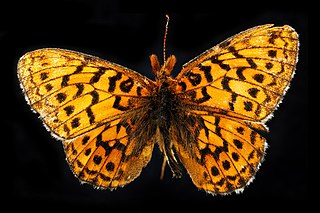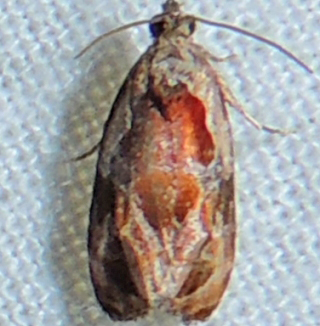Homolagoa is a monotypic moth genus of the family Noctuidae. Its only species, Homolagoa grotelliformis, is found in North America. Both the genus and species were first described by William Barnes and James Halliday McDunnough in 1912.

Hemimorina is a monotypic moth genus in the family Geometridae. Its only species, Hemimorina dissociata, is found in North America. Both the genus and species were first described by James Halliday McDunnough in 1941.
Hymenodria is a monotypic moth genus in the family Geometridae erected by James Halliday McDunnough in 1954. Its only species, Hymenodria mediodentata, was first described by William Barnes and McDunnough in 1911. It is found in North America.
Ptychamalia is a monotypic moth genus in the family Geometridae described by Prout in 1932. Its only species, Ptychamalia dorneraria, was first described by William Barnes and James Halliday McDunnough in 1913. It is found in North America.

Euphilotes battoides, the square-spotted blue or buckwheat blue, is a species of butterfly of the family Lycaenidae.

Emesiini is a tribe of metalmark butterflies in the family Riodinidae. There are at least 2 genera and about 15 described species in Emesiini.

Agathymus alliae, the Mojave giant skipper, is a species of giant skipper in the family Hesperiidae. It is found in North America.

Boloria kriemhild, the relict fritillary, is a species of fritillary butterfly in the family Nymphalidae. It is found in North America.

Pierina is a subtribe of cabbage whites, checkered whites, albatrosses in the family Pieridae. There are about 8 genera and 18 described species in Pierina.

Stenoporpia purpuraria is a species of moth in the family Geometridae first described by William Barnes and James Halliday McDunnough in 1913. It is found in North America.

Hydriomena irata is a species of geometrid moth in the family Geometridae. It is found in North America.

Xanthorhoe alticolata is a species of moth in the family Geometridae first described by William Barnes and James Halliday McDunnough in 1916. It is found in North America.

Chlorosea roseitacta is a species of emerald moth in the family Geometridae. It is found in North America.

Lacosoma chiridota, the scalloped sack-bearer, is a species of sack-bearer moth in the family Mimallonidae.

Mathildana is a genus of concealer moths in the family Oecophoridae. There are at least three described species in Mathildana.
Tallula watsoni, or Watson's tallula moth, is a species of moth in the family Pyralidae. The species was first described by William Barnes and James Halliday McDunnough in 1916.

Zomaria interruptolineana, the broken-lined zomarium, is a species of tortricid moth in the family Tortricidae.

Euphilotes bernardino, the Bernardino blue, is a butterfly in the family Lycaenidae. The species was first described by William Barnes and James Halliday McDunnough in 1916. It is found in North America.
Euphilotes spaldingi, or Spalding's blue, is a butterfly of the family Lycaenidae. The species was first described by William Barnes and James Halliday McDunnough in 1917. It is found in North America.

Tallula is a genus of pyralid moths in the family Pyralidae. There are about 11 described species in Tallula.














